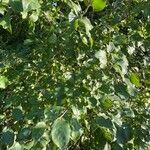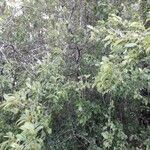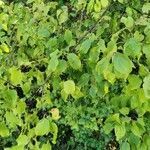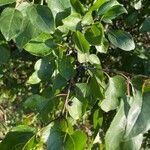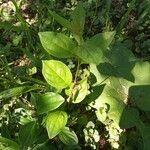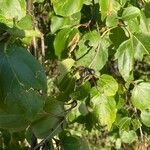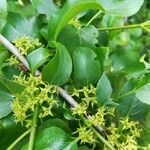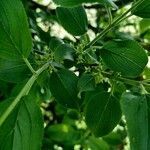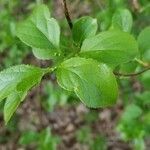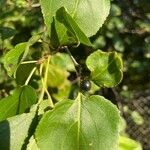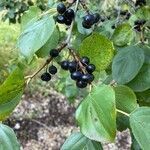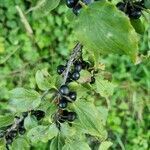Shrubs or trees, (1–)2–8 m, armed with thorns. Branchlets dark to reddish gray or purple, glabrous. Leaves deciduous (often present well after frost), usually opposite to subopposite, rarely alternate, sometimes fascicled on short shoots; petiole 10–27 mm; blade dull green abaxially, glossy darker green adaxially, usually ovate to elliptic-ovate, sometimes broadly elliptic or nearly orbiculate, (2–)4–7 cm, usually 1–2 times longer than wide, herbaceous, base rounded to rounded-truncate or slightly subcordate, margins crenate-serrate, apex acute to rounded, often abruptly short-acuminate, both surfaces glabrous; secondary veins 2–4 pairs, all diverging at nearly same angle or proximal diverging more obtusely. Inflorescences fascicles or flowers solitary. Pedicels 2–4 mm. Sepals 4. Petals 4. Drupes black, globose to depressed-globose, 5–6(–8) mm; stones 3–4. 2n = 24.
Functionally dioecious shrub or small tree to 6 m, some of the branches usually ending in short thorns; lvs mostly opposite or subopposite, or some of them alternate, broadly elliptic, oblong, or elliptic-obovate, 3–6 cm, at least half as wide, the lateral veins (2)3(4) on each side, strongly upcurved; petiole a third to two-thirds as long as the blade; fls appearing with the lvs, 4-merous; sep 2–3 mm; pet erect, lanceolate, 1–1.3 mm in staminate fls, 0.6 mm in the pistillate; style 4-fid half its length; fr black, 5–6 mm thick, commonly with 4 stones; 2n=24. Native of Eurasia, escaped from cult. at many places in our range.
Functionally dioecious shrub or small tree to 6 m, some of the branches usually ending in short thorns; lvs mostly opposite or subopposite, or some of them alternate, broadly elliptic, oblong, or elliptic-obovate, 3–6 cm, at least half as wide, the lateral veins (2)3(4) on each side, strongly upcurved; petiole a third to two-thirds as long as the blade; fls appearing with the lvs, 4-merous; sep 2–3 mm; pet erect, lanceolate, 1–1.3 mm in staminate fls, 0.6 mm in the pistillate; style 4-fid half its length; fr black, 5–6 mm thick, commonly with 4 stones; 2n=24. Native of Eurasia, escaped from cult. at many places in our range.
A shrub or small tree.
